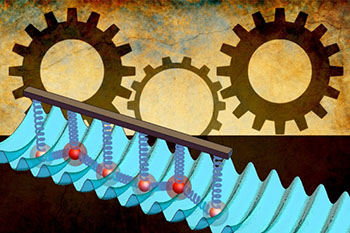
The atom-scale friction simulator created by the MIT team involves pulling a Coulomb crystal of trapped laser-cooled Yb ions (ball-and-spring structure in diagram) across an optical lattice (corrugated blue structure in diagram). [Image: Christine Daniloff/MIT and Alexei Bylinkskii]
Using a clever setup that pits an array of laser-cooled trapped ions against an optical lattice “surface,” scientists have provided an atom-scale simulation of stick-slip friction—and have cast light on the phenomenon of “superlubricity,” when friction can suddenly vanish and surfaces slide over each other without resistance (Science, doi: 10.1126/science.1261422). The researchers believe that the new technique and its results could boost both theoretical studies of quantum behavior and practical efforts involving nanomachines and biological motor proteins.
While we tend to think of friction as a macroscopic phenomenon, with effects visible in automotive braking and earthquake shocks, it occurs on much smaller length scales, all the way down to the atomic realm. Superlubricity has proved particularly intriguing to nanoscientists, since the ability to tune surfaces to the point where they slide across one another without resistance would constitute a handy addition to the toolkit for fashioning nanomachines. But while researchers have made progress in modeling friction and superlubricity at the atomic level, a simulator to provide a test of these models at the atomic scale has been lacking.
Researchers led by Vladan Vuletić of the Massachusetts Institute of Technology (MIT), USA, set out to build such a simulator—and optics enabled the setup on both sides of the frictional divide. The simulator consists of two artificial surfaces that are placed in contact and pulled across one another. One of the engineered surfaces is a simple optical lattice—an optical standing wave with a sinusoidally varying periodic energy potential—that acts as an analogue to a rigid substrate. The other simulated surface takes advantage of recent advances in laser cooling and ion trapping (see Newsroom, 16 March 2015): It’s a so-called Coulomb crystal consisting of an array of up to six laser-cooled trapped 174Yb+ ions, spaced at a distance that the researchers could tune electroscatically.
The team then effectively slid the two engineered surfaces against one another, and measured the resulting frictional resistance as they varied the spacing between the Yb ions. They found that when the ion spacing matched the periodic variation of the substrate lattice, friction was at a maximum; the ions in the Coulomb crystal would become trapped simultaneously in the potential wells of the optical standing wave, with sudden slip once applied force reached a threshold level to overcome that resistance, much like the classic model of an earthquake.
But when the ion spacing was tuned into a mismatch with the optical lattice spacing—placing some ions at potential-energy peaks in the lattice, and some at troughs—the team could make the system behave in a “nearly frictionless” fashion, analogous to superlubricity. A short animation from the MIT press office depicts the two states:
The experiment has some obvious limitations, as it is strictly a 1-D simulation and—in the words of Ernst Meyer, who wrote a commentary accompanying publication of the research—creating physical interactions using optical lattices is “rather far removed from the world of materials science.” Still, Vuletić says that the team’s simulation is the first that has shown the transition from friction to superlubricity on an atomic scale, and the researchers believe that it ultimately could prove useful not only in engineering nanomachines but in understanding important interactions in molecular biophysics.
